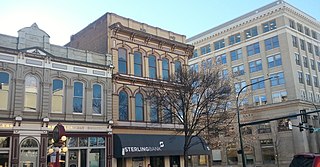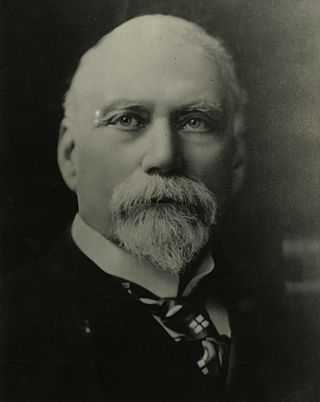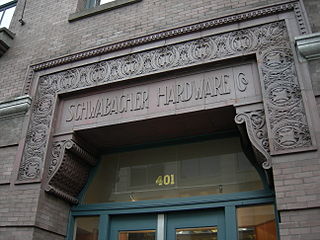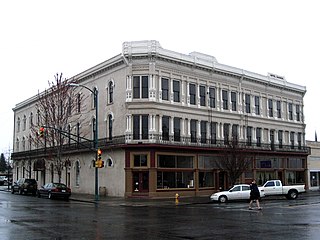
Interstate 82 (I-82) is an Interstate Highway in the Pacific Northwest region of the United States that travels through parts of Washington and Oregon. It runs 144 miles (232 km) from its northwestern terminus at I-90 in Ellensburg, Washington, to its southeastern terminus at I-84 in Hermiston, Oregon. The highway passes through Yakima and the Tri-Cities, and is also part of the link between Seattle and Salt Lake City, Utah. I-82 travels concurrently with U.S. Route 97 (US 97) between Ellensburg and Union Gap; US 12 from Yakima to the Tri-Cities; and US 395 from Kennewick and Umatilla, Oregon.

Walla Walla is a city in Walla Walla County, Washington, where it is the largest city and county seat. It had a population of 34,060 at the 2020 census, estimated to have decreased to 33,927 as of 2021. The population of the city and its two suburbs, the town of College Place and unincorporated Walla Walla East, is about 45,000.
Washington Mutual, Inc—abbreviated to WaMu—was a savings bank holding company and the former owner of WaMu Bank, which was the United States' largest savings and loan association until its collapse in 2008.

Whitman College is a private liberal arts college in Walla Walla, Washington. The school offers 53 majors and 33 minors in the liberal arts and sciences, and it has a student-to-faculty ratio of 9:1. Whitman was the first college in the Pacific Northwest to install a Phi Beta Kappa chapter, and the first in the U.S. to require comprehensive exams for graduation. Alumni have received 1 Nobel Prize in physics, 1 Presidential Medal of Freedom, 7 Rhodes Scholarships, 1 Marshall Scholarship, 50 Watson Fellowships, and 93 Fulbright Fellowships.

The Federal Reserve Bank of San Francisco is the federal bank for the twelfth district in the United States. The twelfth district is made up of nine western states—Alaska, Arizona, California, Hawaii, Idaho, Nevada, Oregon, Utah, and Washington—plus the Northern Mariana Islands, American Samoa, and Guam. The San Francisco Fed has branch offices in Los Angeles, Portland, Salt Lake City, and Seattle. It also has a cash processing center in Phoenix.
Washington State Penitentiary is a Washington State Department of Corrections men's prison located in Walla Walla, Washington. With an operating capacity of 2,200, it is the second largest prison in the state and is surrounded by wheat fields. It opened in 1886, three years before statehood.

State Route 125 (SR 125) is a state highway in Walla Walla County, Washington, United States. It travels 24 miles (39 km) south from the city of Walla Walla to the Oregon state border and north to a junction with SR 124 near Prescott. The highway continues south towards Pendleton, Oregon, as OR 11. SR 125 also has a spur route in Walla Walla that connects it to an interchange with U.S. Route 12 (US 12).

Miles Conway Moore was an American politician who served as the 14th and last Territorial Governor of Washington Territory. He served seven months in office as governor, his two-year term ending prematurely when Washington attained statehood in November 1889.
The Walla Walla Union-Bulletin (U-B) is a newspaper based in Walla Walla, Washington and owned by the Seattle Times Company. It publishes daily except Saturdays.

The Schwabacher Brothers—Louis Schwabacher, Abraham (Abe) Schwabacher, and Sigmund (Sig) Schwabacher —were pioneering Bavarian-born Jewish merchants, important in the economic development of the Washington Territory and later Washington state. They owned several businesses bearing their family name, first in San Francisco, then in Walla Walla, Washington, and later in Seattle. Notable among these businesses were Schwabacher Bros. of San Francisco ; Schwabacher Bros. & Company, the Schwabacher Realty Company, the Gatzert-Schwabacher Land Company, and the Schwabacher Hardware Company, all ultimately based in Seattle; and the Stockton Milling Company.
Frances Shipman Penrose Owen was a community volunteer in Seattle, Washington, a 22-year member of the Seattle School Board and the first woman on the Board of Regents of Washington State University, the state's land-grant research institution, serving from 1957 to 1975.

The Bank of California Building is a landmark building located at 815 2nd Avenue in Seattle, Washington. It is located mid-block adjoining the Exchange Building. It was built by the Bank of California in 1924 and has been continually used as a bank ever since. It housed the offices for the Bank of California until 1973 when a new building, the Union Bank of California Center was built at the corner of 4th and Madison Streets. Ironically, this newer, larger building is no longer used as a bank and instead is occupied by a Bartell Drugs store. The original Bank of California Building was retained as a branch office until being sold to the Puget Sound Mutual Savings Bank in 1982 which was headquartered in the building until 1993 when through a series of mergers and acquisitions the bank became a branch of Key Bank, which it remains to present day.

Colman Dock, also called Pier 52, is the primary ferry terminal in Seattle, Washington, United States. The original pier is no longer in existence, but the terminal, now used by the Washington State Ferry system, is still called "Colman Dock".

The Dacres Hotel is a historic hotel in Walla Walla, Washington, United States. Rebuilt from the ruins of Walla Walla's first brick hotel, the 1873 Stine House, the Italianate building was re-opened in 1899 by James E. Dacres. The building is a rare and exceptional local example of the pre-fabricated cast iron facades manufactured by the Mesker Brothers. Bennes, Hendricks & Tobey remodeled the building in 1907. It was added to the National Register of Historic Places on November 5, 1974.
Wayne Chabre is an American sculptor from Walla Walla, Washington. His works have been described as "whimsical". Many of his sculptures are functional, such as gargoyles and downspouts; railings and gates; lighting, pavilions, fountains, and benches.

The architecture of Seattle, Washington, the largest city in the Pacific Northwest region of the U.S., features elements that predate the arrival of the area's first settlers of European ancestry in the mid-19th century, and has reflected and influenced numerous architectural styles over time. As of the early 21st century, a major construction boom continues to redefine the city's downtown area as well as neighborhoods such as Capitol Hill, Ballard and, perhaps most dramatically, South Lake Union.
Valley Transit is a public transit operator in Walla Walla County, Washington. It operates 10 routes in the cities of Walla Walla and College Place.
The history of Walla Walla, Washington begins with the settling of Oregon Country, Fort Nez Percés, the Whitman Mission and Walla Walla County, Washington.
Frank A. Blethen is an American executive who is the publisher of The Seattle Times and chief executive officer (CEO) of The Seattle Times Company, based in Seattle, Washington, United States. He is a fourth-generation member of the Blethen family, which has owned the newspaper since 1896, and took over as publisher in 1985. He also served as publisher of the Walla Walla Union-Bulletin, a newspaper owned by the company, in the 1970s. During his tenure as publisher, the family's control of the newspaper declined, along with the profitability of the newspaper industry in general. The newspaper entered into a joint operating agreement with its rival Seattle Post-Intelligencer that lasted until that newspaper ceased printing in 2009.












